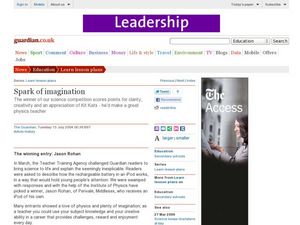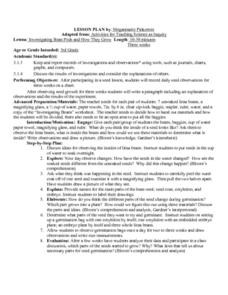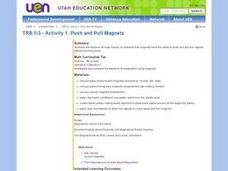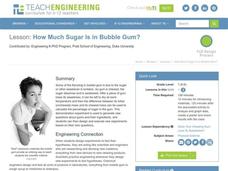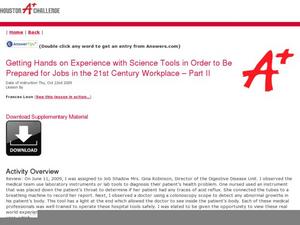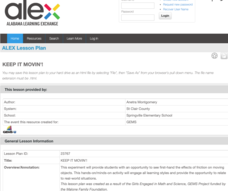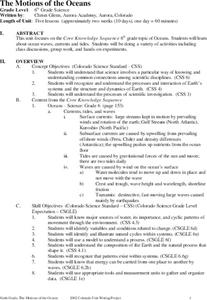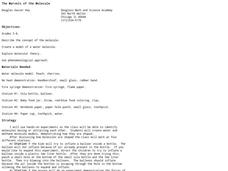Curated OER
ESL Activity - Authentic Cooking Experience
Students encounter imperatives used for the instructions for this cooking experience. They review selected vocabulary terms for food and the process of cooking. Students identify adverbs of sequence (first, then, etc.). They follow the...
Curated OER
Head, Heart, Hands, Health
Fourth graders complete a compare and contrast activity for American agriculture historical events. In this historical events in agriculture lesson, 4th graders review a timeline and complete research for agriculture in the 20th century,...
Curated OER
Spark of Imagination
Young scholars consider the power of physics. In this current events lesson, students listen to a lecture that explores the power garnered by iPod batteries and how they work.
Curated OER
Investigating Bean Pods and How They Grow
Third graders observe and create a record of seed growth over time. After planting a seed, 3rd graders record their observations of the seed's growth over a three week period. Upon conclusion of the experiment, they write a paragraph...
Curated OER
Hovercraft Racers!
Students gain first-hand experience on how friction affects motion. They build a hovercraft using air from a balloon to levitate a craft made from a compact disk (CD), learning that a bed of air under an object significantly reduces the...
Curated OER
Take Charge!
Students induce an electrical charge on various objects, and experiment with electrical repulsion and attraction. They define related vocabulary, play Bingo and complete a take-home quiz.
Curated OER
Crystals in the World around Us
Students grow a number of crystals, ask questions and experiment. They have a display showing their crystals in various stages of development. Additionally, they have models of crystals to take home. They study the forces that shape...
Curated OER
TE Activity: Super Spinners!
Students make spinners to investigate rotational inertia, rotational speed, angular momentum, and velocity. They make two sets of spinners that have different mass distributions and shapes. They complete a worksheet while experimenting...
Curated OER
How to Clean Up An Oil Spill
Students practice cleaning up an oil spill. In this good citizenship lesson, students experiment with different cleaning agents to see which ones clean oil off a soft toy. They compare this experiment with the volunteers helping with the...
Curated OER
Push and Pull Magnets
Fifth graders pull a paper clip sitting on paper with a magnet beneath the paper. They experiment to see what happens if they substitute the paper with thicker paper and other materials (plywood, glass, foil, etc.)
Curated OER
Go with the Flow
Students gain an understanding of the difference between electrical conductors and insulators, and experience recognizing a conductor by its material properties. They build a conductivity tester to determine whether different objects are...
Curated OER
Does Your Chewing Gum Lose Its Flavor?
Young scholars determine the amount of sugar in various types of gum. They chew a piece of gum until it loses its flavor and leave it to dry in order to weigh it and determine the amount of mass lost, and describe an experiment to...
Curated OER
Soapy Stress
Young scholars investigate the three types of material stress related to rocks. They identify the three types of stress, conduct a simulation by breaking bars of soap using only their hands, and complete a worksheet.
Curated OER
How Much Sugar is in Bubble Gum?
Students conduct an experiment to determine the percentage of sugar in various types of gum. They weigh the gum after chewing it to determine the amount of mass lost from each piece of gum, analyze the data, and create a graph of the...
Curated OER
TE Activity: Oil Spill Cleanup
Students experiment by creating an oil spill and trying a number of clean up methods. They determine which methods are the least costly and most effective. They role play as an environmental engineer and as an oil company owner who must...
Curated OER
Jobs in the 21st Century
Young scholars understand the tools that will be used in the lab in the 21st century. In this job preparation lesson, students experiment and understand how to use lab equipment. Young scholars will write about the lab tools they've...
Alabama Learning Exchange
Keep It Movin'!
Learners conduct an experiment to study friction. They complete a KWL chart on friction and conduct an activity about the amount of friction on a moving object. To conclude, pupils create a table or graph of the data collected and they...
Curated OER
Billions of Bubbles
Students conduct an experiment with bubbles. In this observation and comparison lesson, students read Bubbles, Bubbles, Everywhere and conduct an experiment where they test different kinds of liquids to see which is the best for a...
Curated OER
A Constructivist Version of the Snail & Elodea Lab
Students explain the importance of having a control when setting up an experiment.
Curated OER
The Motions of the Oceans
Students examine the topics of ocean waves, currents, and tides. They locate and label ocean currents on a world map, conduct experiments, analyze key vocabulary, view demonstrations and record the data, and complete handouts.
Curated OER
The Marvels of the Molecule
Students experiment with common substances to observe molecular behavior. In this molecular properties lesson, students move through four stations as they try to inflate a balloon inside a bottle, pour water from a jar, and observe how...
Curated OER
Exercise and Heartrate
Fourth graders experiment to find the effects of exercise on the heart rate. In this exercise and heart rate lesson, 4th graders create questions about exercise and heart rate. Students use the scientific method to test and analyze...
Curated OER
Ocean Life
Students explore the topics of ocean water salinity, ocean life zones, marine life classification, and ocean food chains. They observe demonstrations, conduct experiments, complete quizzes and handouts, and analyze key vocabulary.
Curated OER
Tornado!: Types and Formation
Students discuss the different types of tornadoes and how they form. Working in groups, they record journal entries by conducting experiments with water bottles simulating vortex formation.




